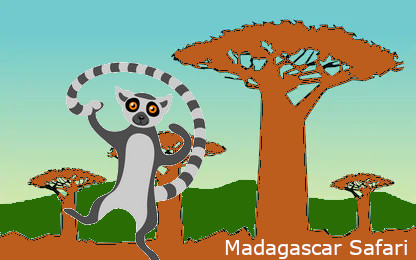- INTRODUCTION
- MALAGASY CULTURE
- MALAGASY TRADITIONAL SPORT
- MALAGASY CUISINE
- BEACHES AND RIVERS
- MONEY AND CREDIT CARDS
- PURCHASE TIPS
- SITES AND ACTIVITIES
- MONUMENTS
- MALASY HANDICRAFTS
- TIPS FOR TRAVELLERS
- MADAGASCAR CONNECTING FLIGHTS
- MADAGASCAR NATIONAL PARKS AND RESERVES
- FAUNA AND FLORA OF MADAGASCAR
- PUBLIC HOLIDAYS IN MADAGASCAR
- THE SOUTH WEST AND WESTERN REGIONS
- THE SOUTH EAST REGION
- THE NORTH WEST REGION
- THE NORTH EAST AND EAST REGIONS
- THE CENTRAL HIGHLANDS
MADAGASCAR: THE CENTRAL HIGHLANDS
THE CENTRAL HIGHLANDS
It includes the capital, Antananarivo, sheltered in the central Highlands which is mild and temperate, and stretches to the south as far as Ambalavao. Hills, extinct volcanoes and green scenery of groves, vineyards, terraced rice fields are its main features.
Antananarivo
One of the most picturesque capital in the world with its brick houses perched on the hillsides, its stairways, and its swarming small street trades. Up on the hill stretches the ancient town with its freestone churches, ancient royal places, the newly renovated stately residences, and a grandiose panoramic view over the plains beneath.
The sacred hills
On each one of the 12 sacred hills, Andrianampoinimerina – a famous and powerful King- established a wife to seal the unity of his kingdom. Ilafy, Alasora, Antsahadinta.., but above all Ambohimanga which Unesco has classified as World Heritage sites.
Itasy (RN1)
This region of extinct volcanoes is a hundred kilometres or so from the capital. The Lake Itasy, lies over 45 km2 in a lanscape of ancient craters and basaltic fields, surrounded by a constellation of 40 other smaller lakes. The lily waterfalls, with foaming waters falling from a 23 m height. The Kasigie dominates the whole region with its stromboli cone.
From Antananarivo to Andasibe (RN2)
At PK 59, turning to Mantasoa, its lake, historical vestiges and its (very) good restaurants. The Gorges of the Mandraka offer a splendid panoramic view. At PK 115, Moramanga, and its “gendarmerie museum” exhibiting a collection of ancient cars, uniforms, weird catches. Andasibe, one of the most visited National Parks of the island.
From Antananarivo to Anjozorobe (RN3)
At 16.3km from Antananarivo, turning to the sacred hill of Ambohimanga. Anjozorobe, about 90 km to the north of the capital, is the largest fragment of the old primary forest in the Highlands. It is recommended for ornithology lovers.
From Antananarivo to Vakinankaratra (RN7)
At PK 68, Ambatolampy is the capital of mimosa in july-august and also of craft manufacturing of cooking-pots and baby-foot tables. Hiking to the massif of Ankaratra (Tsiafajavona, 3rd highest summit in the island). Excursion to Tsinjoarivo (46 km) at the furthermost south east bounds of Imerina. Antsirabe, a pretty thermal town located 170 km from the capital, combining a typical malagasy style with the tranquillity of a small european provincial town. A town with transition weather because of its geographical position. Antsirabe is a real hub for agri-business, textile and tobacco industry; it deserves to be visited by rickshaw. The legendary Lake Tritriva, which water level decreases in rainy season. The Vakinankaratra is one of the regions of the Highlands where there are still a few hectares or so of primary forests where one may find lemurs.
From Antsirabe to Fianarantsoa (RN7)
Ambositra at PK 258. The right spot for marquetry and “savika”, a traditional and very spectacular bullfighting event. Starting point for excursions to the Zafimaniry land. Fianarantsoa, a city built on 3 levels, from the top the Tanana Ambony, the highest level and its old and very picturesque quarters classified as a protected area because of its historical and architectural interest. Main town of the only province that gathers the highlights of the central plateau, the luxuriant east coast and the immense spaces of the south. It is in the heart of a region reputed for its vineyards, tea plantations and terraced rice fields. The Fianarantsoa-Manakara railway line offers very spectacular sights with at times a very acrobatic route on the cliff side. One of the most best tours of Madagascar Tours.
From Fianarantsoa to Ambalavao (RN7)
From Vatoavo pass, view on the plains of Ambalavao studded with villages, groves and vineyards. Village of crafts (“arindrano” fabric, antemoro paper) and second zebu market in the island. Picturesque houses with terraces of varied design. Starting point for hiking to the massif of Andringitra, the highest accessible summit in Madagascar, hot spot for mountain climbing and paragliding. Stop in the small reserve of Anja along rN7 with its hundreds of affectionate lemurs, its caverns where the local people lived one century ago.
